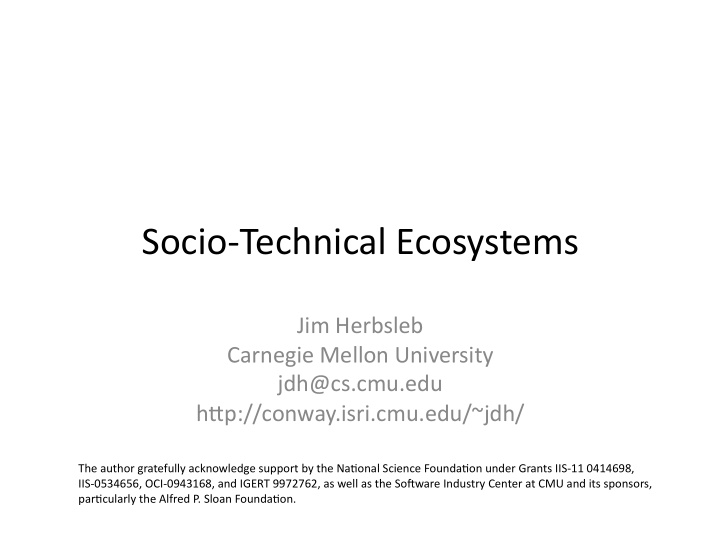



Socio‐Technical Ecosystems Jim Herbsleb Carnegie Mellon University jdh@cs.cmu.edu h@p://conway.isri.cmu.edu/~jdh/ The author gratefully acknowledge support by the NaIonal Science FoundaIon under Grants IIS‐11 0414698, IIS‐0534656, OCI‐0943168, and IGERT 9972762, as well as the SoZware Industry Center at CMU and its sponsors, parIcularly the Alfred P. Sloan FoundaIon.
Agenda • Socio‐technical ecosystems – What are they? – Why are they important? – Why should we care? • What do we know about them? – 2‐3 examples – What challenges do they face? • What are the implicaIons for a discipline of requirements?
Technology & How We Organize • The EvoluIon of Socio‐Technical Systems – Eric Trist, 1950 – Short wall versus long wall coal mining • Co‐evoluIon of organizaIons and technology – Elevators – Telephone • Claude Fischer, America Calling: a Social History of the Telephone – Internet – Web – Web 2.0
Ecosystems – Many examples • CollecIons of open source projects • Wikipedia, Facebook, Flikr, etc. • App stores (iPhone, iPad, Facebook apps) • Ultra‐large systems
What DisInguishes “Ecosystems”? • Many types of developers, contributors, and users • ParIcipants’ acIons affect each other, both as individuals and populaIons – Predator/prey, symbiosis, parasiIsm, compeIIon, relaIve advantage, etc. • Environments, interacIons create niches • Examples – Eclipse (2009) – VistA (gelng under way) – Virtual scienIfic organizaIons (1 st workshop next week)
From March 2008 Eclipse ExecuIve Director's Report: 6 h@p://www.eclipse.org/org/foundaIon/membersminutes/20080317MembersMeeIng/DirectorsReport.pdf
Central Players In Open Source FoundaIons Commercial Firms Developers 7
4 Empirical Studies • Firms and FoundaIons • Firms and Firms • Firms and Individuals • Individuals and Individuals 8
4 Empirical Studies • Firms and Founda,ons • Firms and Firms • Firms and Individuals • Individuals and Individuals 9
Firms and FoundaIons: Guiding an Ecosystem to Promote Value 10
The Research Problem • Some research has been done about why individual focused OSS projects uIlize foundaIons • Li@le research has addressed why commercial firms would contribute IP to foundaIons – Large monetary cost – Giving up some control – Possibly increased work • What does the foundaIon do to drive value? 11
Data • Semi‐structured interviews with Eclipse FoundaIon staff and employees of member companies – 38 interviews with 40 individuals • Face‐to‐face meeIngs at EclipseCon 2007 and 2008 • ParIcipaIon in Eclipse members meeIngs 12
Driving Value CreaIon • Non‐market player • Plaporm for innovaIon • IntroducIon of process • Value of the Eclipse brand and markeIng • OrganizaIonal structure driving value 13
Non‐Market Player • Eclipse grew out of IBM's old VisualAge partners • Small firms had to worry about being stepped on • Allows innovaIon without worry about “Gorillas” – Culture of transparency, openness, meritocracy, permeability • Opens the door for distribuIon based business models 14
Plaporm for InnovaIon • FoundaIon acIvely recruits new members • Encourages components to be as modular as possible – Modularity == Independence from other components • Create projects outside of Eclipse and bring inside later • Push usage outside tradiIonal realms 15
Takeaways • Eclipse FoundaIon has taken concrete steps to build ecosystem • Governance structure ensures all can provide input • Non‐market nature is very beneficial • Services provided for members are worth the cost 16
Firms and Firms: Business CollaboraIon Through Open Source 17
The Research Problem • Much data about how individuals interact in OSS • Li@le data about how firms collaborate • Is there an overdependence on single firms? • How collaboraIve are OSS ecosystems? 18
Data • Projects from Eclipse FoundaIon • Two level project hierarchy – Top Level Projects (11)s – Sub Projects (89)s • Data from version control system and IP‐zilla • Ties individuals to code changes and firms • Compared with data from GNOME 19
How Does CollaboraIon Occur? CollaboraIon is rare at the level of subprojects. eclipse.plaporm 20 tools.cdt
CollaboraIon in CDT IBM Leaves/QNX Lead WindRiver Joins/IBM Lead WindRiver Leads 21
Who Builds the Plaporm? 22
Takeaways • ParIcipaIon in an OSS ecosystem may require li@le collaboraIon with other firms • Many key porIons of Eclipse are centered on IBM • Allows IBM to exert great influence, even though no longer at the center • The organic community around GNOME shows much more collaboraIon 23
VistA • Most widely‐deployed Health IT system • Not a well‐funcIoning ecosystem – VA writes code, pushes out patches, takes nothing back in – MulIple distribuIons – Disagreements about licenses – Fights over trademarks – No central authority
IceCube: Example VO in OSG • Neutrino Observatory • Cube of ice 1km on a side, under geographic south pole, ~2km under surface • OpImized for detecIon of astrophysical neutrino sources • Small holes drilled enIre length, wires with sensors • SoZware processes detector data – Major data reducIon at site – Pre‐processing at U Wisconsin – IceTray framework, bundled with core of modules – Post‐docs and grad students write soZware for analyses for specific papers • CollaboraIon of hundreds on each paper
IceCube Detector Array
Four Fundamental Problems in Design of Socio‐Technical Systems • Architecture • Business opportuniIes • CoordinaIon • Governance
Asking a Different QuesIon • Rather than ask the tradiIonal quesIon: – “How can I specify the system that my stakeholders need?” • Maybe we should also ask: – “How can I set up the socio‐technical system that will allow users, consultants, businesses, and everyone else to cooperaIvely build what all my stakeholders need?” – “Even though those needs are currently unknowable and evolving . . .”
Recommend
More recommend